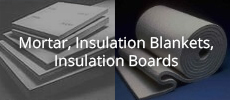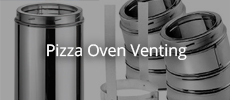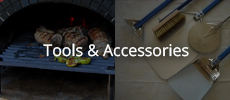X
-
UtahBeehiver Thank you so much for the insight, I’m thinking the perlite is just that edge better as far as obtaining locally and not having to get into shipping fees. Waterproof isn’t too big for me (added bonus if it was) doing weep holes and tile not mater what anyways.
Trying to read and understand this K value.... .55 vs .75, the perlite won’t “hold” the heat as long? So I may not get long cooks out of a firing? Or am I splitting hairs?
thanks again everyone, happy thanksgiving weekend!
Leave a comment:
-
Gulf reminded me that the PDFs were posted earlier and I was out of pocket then. So here is my take, either product has plusses and negatives to CaSi( ieThermoGold 12) or AlSi (Forno Bravo)
Insblok 19, Pros 1900 F service, K .55, Cons low side of compressibility 38 psi at 10% vs 100 psi at 5% of CaSi, (meaning kind of soft to support the oven, recommend 70 psi @ 5%), Perlite Sproule 1200, might be water resistance, although this particular brand does not say so, Good compression, 80 psi at 5% , Cons higher K value 0.74 (but still good), lower service temp at 1200 F but you will not see this temp on the bottom side of floor brick.
Leave a comment:
-
The specs on a specific perlite board is needed to give a comment. I saw one posted earlier this year and it appear to be a good substitute and was water resistance as well.
Leave a comment:
-
Fellow builders, especially the moderators, are usually quick to jump in. I'd venture since no one offered info on Perlite board, they're possibly not familiar with the product? Like you, I do know Insblock-19 has been used often. I almost used it myself. Without validation from those in the know for the Perlite product, I'd go with Insblock. Sorry I can't be of more assistance.
Leave a comment:
-
Can't comment on the insulation, I'll leave that to those that know.
I'll pass on what I recall regarding lime, and again, there are others that may know better, they may post afterwards:
Lime, I'd recommend you look for Type S instead of that Type N in the photo.
While looking, don't confuse MORTAR types S and N with LIME types S and N. Twenty-six letters to choose from, and they had to pick the same letters to designate?
Types S and N differ in the percentages of magnesium carbonate and calcium carbonate in the two limes. My remembrance is that essentially, N requires additional hydration by the user before using it in mortar.
I am not a mason, so take this for what it's worth. Free internet advice, lol. But I have been doing concrete and mortar work on some way shape or form for longer than I'd care to admit. Type S out of the bag is ready to use in mortar. Type N, personally I've never used it over the years. But my understanding is that If you do use it, you should allow it to slake for a day or two, and even then, it's sort of a crap shoot as to handling/plasticity and end strength, etc.
Example of Type S: https://www.homedepot.com/p/Chemical...5040/202616008
Leave a comment:
-
procrastination is a son of gun!! Finally got over this hump, feel good about it! Couple questions, 1) anyone have insight on the insblock vs perlite board? And measuring across me floor I do get 42 1/4”, most likely little discrepancies in my cutting the brick. 2) does this matter right now or I can correct this once going up? 3) type n on lime good? From what I am finding it comes into “stickiness”?2 Photos
Leave a comment:
-
UtahBeehiver or any engineers out there... Any insight on either Perlite or InsBlock-19 being better than the other? For local ability to get they are both fairly price comparable... One more water absorbent then the other? (I am still doing weep holes and tile" Thank you all for the help.
Leave a comment:
-
There is a a lot of pulp and paper industry in South Georgia. That means boilers that have to be serviced on a regular basis. The mills will have a local source in the area I'm sure.South East coast...not easy to find Cal Si,
The Perlite board looks good as for as compression strength. But, I will let others comment on that and the insulation factor. Both are above my paygrade to read on the product data sheets.
There have been a lot of discussions on the forum about Insblok 19. (I have includeded the discussions search and the product data sheet in the links. I know that some have used it. Look through the discussion link. But, the compression strength is very low if I am reading it right. Again, I will defer to the engineers on the forum.Last edited by Gulf; 10-20-2020, 04:36 PM.
Leave a comment:
-
South East coast...not easy to find Cal Si, unless you want to spend some $$ in shipping...anyone hear of Perlite board? I will attach specs, otherwise I may be driving to Charleston to save shipping costs and get my Thermo 1200.
And just got off phone with a different local place and they carry a product called Insblok19...anyone hear of this?Attached FilesLast edited by edonovan; 10-20-2020, 09:43 AM.
Leave a comment:
-
My point was simply to put your best face towards the fire, whether it be the cut or factory end. Obviously if you've tapered your cuts, that's going to infer your "best" fitted end is the tapered end that will be facing the flame. Mongo, we're saying the same thing...best face towards the flame, the other end will be covered with insulation. My original dome bricks had been used, so my best face was the cut end. You are absolutely correct that performance wise or structurally it makes no difference, but if you are cleaning off excess mortar from the inside, it's easier if it's smoother and clean edges fit better and inside joints require much less mortar.
Leave a comment:
-
Definitely looks like a buff colored firebrick.Originally posted by edonovan View PostThanks Mongo,
So would I leave the discrepancy in bricks towards the exterior of the dome? I think it is just material lost with the blade cut.
I feel the same on the 2x 2” so that confirms that.
and glossy cut brick sounds like what I’m looking at
lets try this picture thing again...
I was taught way back when to have the factory face as the visible show face, but that's simply for uniformity and visual appeal. In this case (WFO), it really does not matter. It's an aesthetic choice, not really a structural or performance choice. The way I cut my bricks (in halves at first, then in thirds for the higher up chains) I have the uncut factory side of the brick facing the flame, as my cuts are taper cuts on the sides of each brick. So for my cut bricks, one uncut factory side faces the interior flame, the other uncut factory side faces the exterior dome insulation, and the two cut sides of each brick, which are tapered, are mortared to their adjacent bricks.Last edited by mongota; 10-10-2020, 12:40 PM.
Leave a comment:





Leave a comment: